Veteran’s Testimony – James K. Sunshine 42d Field Hospital
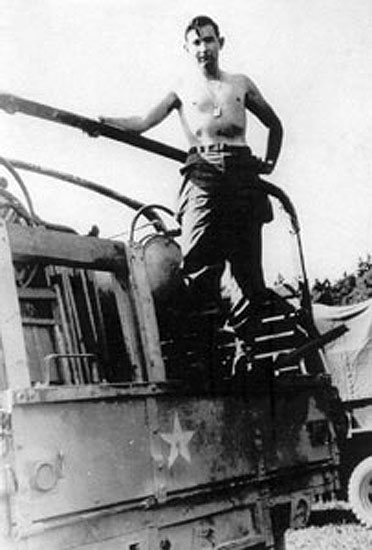
Near Landshut, Germany, spring of 1945 –
J.K. Sunshine, in the back of 6 x 6 truck,
just finished loading some our surgery equipment …
Introduction:
Part of the following story was written as a separate article by WW2 Veteran J. K. Sunshine, and published under the title “War Stories” in the magazine ‘Providence Sunday Journal’ in 1994. Excerpts are being reproduced here with kind permission of the author. Some additional notes relating to the Veteran’s service years with the 42d Field Hospital were further received and are also reproduced here with the veteran’s agreement.
I was born June 3, 1924 and lived in Ohio. I was a freshman at Oberlin College, where I joined the Enlisted Reserves in late 1942. I left College in March and asked for my orders. I entered the Army of the United States in 1943, at age 19. I joined the 42d Field Hospital at Cp. Carson, Colorado Springs, Colorado (Division Camp) in August, after having gone through Basic Training at Cp. Grant, Rockford, Illinois (at the time, the Hospital was commanded by a Colonel Campbell) I was assigned to the Third Platoon. We drilled, learned, trained, set up ward tents again and again, and were assigned to various parts of the base Hospital for further medical training. In November 1943, we boarded a train bound eastward and ended up at Ft. Bragg, Fayetteville, North Carolina, to learn how the Airborne tackled gliders, and then moved on to Laurinburg-Maxton Army Air Base, North Carolina, where we learned to pack and pull all our hospital equipment into CG-4A gliders, which, we were told, we were to ride into France. In December 1943 we were given Christmas leave, and after I returned to my station, all three Platoons were moved to Ft. Lee, New Jersey, our Staging Area for embarkation via New York P/E. We crossed the Atlantic without being hit by anything (we were lucky) and landed in Glasgow, Scotland in January 1944. From there we were trucked to Bromyard, Herefordshire, (between Worcester and Hereford) which would become our UK base from about January 15 to May 15, 1944.

March-April 1944, Bromyard, Herefordshire England. The 12th century Church became the unit’s place of worship with services held each Sunday.
United Kingdom – France – Germany:
In England, we uncrated and unpacked our medical instruments and supplies, continually practicing, pitching ward tents, lived in Nissen huts, grew accustomed to local usages, learned the rituals of the 14 village pubs, listened to the usual jokes about: ‘Yanks, being overpaid, oversexed, and over here’, and made friends with local girls. I was not quite 20 at the time. About mid-May we were transferred to a town in Wales (I can neither pronounce nor spell its Welsh name), near Barry, in Glamorgan, Wales. We then boarded Liberty Ships, each Platoon on a different ship, but we didn’t move for reasons unknown to us. We just sat and waited for about 10 days, unable to leave. The waiting was unbearable. About June 2 or 3, we went down Bristol Channel, and around Land’s End to the English Channel and finally crossed over to Normandy, where we sat off Utah Beachhead for a day or two watching the ‘show’ … One Platoon (i.e. the Second) was torpedoed or struck a mine. All personnel survived, but the equipment was lost.

Contemporary postcard from Laurinburg-Maxton Army Air Base.
First, Second and Third Platoons were together (as far as I can recall), and set up camp in a big field northwest of Ste-Marie-du-Mont (this was near Le Grand Chemin -ed). My Platoon, the Third, was commanded by a Major Bartolini. We were joined by the 45th Field Hospital, and with our arrival we now had the makings of 4 complete tent Hospitals in one big field. Together we functioned as the “Utah Beach Hospital”, treating all sorts of wounds and evacuating casualties back to England. About mid June 1944 (this was 17 June -ed), the Platoons split up, each one assigned to a separate Division, and that’s how we would function for the rest of the war.
… For most of the war I worked for the Tec 3, in charge of the 42d Field Hospital’s Surgery Section. Field Hospitals had their own staff of Medical Officers, Enlisted Technicians and assigned Nurses, but these were supplemented by attached Surgical Teams (Surgeons, Anesthetists, and Surgical Technicians). These teams were highly skilled and did most of the real work. Following my promotion, I ran the 42d surgery and was responsible for its operation. Most of the time I ‘circulated’, meaning I did non-sterile tasks for the operating teams, and from time to time did ‘scrub’ and assisted surgeons during operations. Near the end of the war I was promoted to Technician 3d Grade (I was a Surgical Technician – MOS 861 – corresponding to S/Sgt). After the war, while waiting to go home, we were stationed in Schweinfurt, Germany. As I didn’t have enough points, my ASR score was only 77 (out of the necessary 85 points). A few of us were re-assigned to the 79th Infantry Division and finally went home with them. My only problem was that as a S/Sgt (Tec 3) I was put in charge of an Infantry Squad. I looked at the Machine Guns on the floor of the orderly room and wondered what the hell I was supposed to do with them. In all my time with the Army, I had never fired a gun!

Period postcards from Camp Carson (top left); Camp Grant (top right) and Fort Bragg bottom.
For a long time I thought I would never forget the years 1944 and 1945 when I was a medical soldier in what is still considered our ‘greatest’ war. Details of people, places, and incidents of that time remained in my mind for decades. Years later I could picture each spot where the 42d Fld Hosp (-ed) pitched its tents as it moved across Europe from Normandy to Germany, I could recall by wound if not by name many of the torn and broken bodies that passed our hands to be cut, patched and sewed together, or shipped off by the truckloads to Graves Registration. Now those recollections are not so clear. Images come but are indistinct, and they do not stay long. Although these words may appear to be like a journal written as the events occurred, they were, in fact, written quite recently, and are based upon an old scrapbook assembled in 1945 that has remained in a succession of back cupboards for half a century. There is no battle action here. A Field Hospital (-ed) does not fight, but it does offer an unusual vantage point from which to observe a war. Finally, I do not offer these recollections as anything more than what they are, fragments of experience of a time long gone that in an Anniversary Year (1994 –ed) may be of interest to those who were not there.
… Wales, May 20, 1944:
We are kept behind barbed wire, and not allowed out of this vast encampment of men and machines waiting for the war. The surroundings are bleak, the weather is foul, and we have nothing to do. It is hard to stay dry. Mud is everywhere, and the air is heavy with the smell of burning coal. The Motor Pool people are kept busy changing the trucks, jeeps and ambulances into amphibious vehicles by extending exhaust pipes above the presumed depth of the beachhead water and smearing waterproofing gunk all over the vital parts of the engines. We pass the time playing cards, sheltered from the drizzle in pyramidal tents. Someone paints our duffle bags with three parallel yellow bars to identify our beachhead destination: UTAH. There is one reason to be grateful. Our orders have been changed. Back in the States our last training was at a base in North Carolina (Laurinburg-Maxton Army Air Base, North Carolina, Combat Glider Training Center –ed), where we learned to pack ourselves and our hospital equipment into small gliders, airplanes without motors designed to be towed behind bigger conventionally-powered planes and then cast loose to glide to earth. It doesn’t seem like a foolproof system. The gliders are made of pipes and cloth and seem like fragile toys. The change in orders, we are told, meant boats, not gliders. It sounded a lot better. We are taken in trucks to the port of Barry on the Bristol Channel. The harbor is jammed with shipping. Long lines of men, trucks and guns waiting on the wharves to board freighters and transports lying bow to stern at the piers. We load, but the boats do not move for reasons not given to us. We wait for days, unable to wash or leave the boats. The waiting is unbearable. Finally, we get under way and steam down the channel in a long line and head for Land’s End.

End June 1944, in Normandy. Ralph Winkle and Dave Brand are playing cribbage in a Normandy cow pasture
The Channel, June 3, 1944 (my birthday):
We crowd the deck to watch Vera Lynn’s white cliffs recede into the distance, trying not to think of what was over the horizon, or under the water for that matter, but enormously excited all the same. To the right and left, ahead and astern, the gray sea is crowded with hundreds of wallowing cargo vessels, troop transports, barrage balloons rising on tethers from their decks to discourage diving enemy planes. I have never seen so many ships at one time. The long slow-moving columns extending over the horizon are escorted by patrol craft protecting the convoy’s edges. In the holds below the deck of our Liberty are tanks and guns and trucks and men packed into narrow pipe berths stacked five deep. Someone tells me that in the bottom hold are 100 trucks loaded with 105mm artillery ammunition. I try not to think of it.
…. Off Utah Beach, Normandy, June 6, 1944:
We are on deck watching the show. Guns are firing constantly, the noise is incessant, and smoke rises from the beach area and from further inland. Around us scores of ships wait to unload. Landing craft plow back and forth to the beach. A battleship, far beyond the perimeter of the anchored armada fired salvos from her 14-inch guns (-ed) over our heads, and the shells sound like boxcars ripping through the air, and we can actually see them go. On the radio we hear the BBC describing the progress of the battle, how the Navy is trying to knock out a steeple with a sniper’s nest in it. We can see the steeple and hear the shells. It takes a long time and a lot of shells. Night, the rocket barges fire toward the battle, turning darkness into the Fourth of July, the long fiery stream of rocket tails arching into the sky. We had never seen anything like it. Eventually, we go to sleep, but down in the holds below the waterline, lying in our pipe berths we feel trapped. What if a sub gets through the perimeter? What about all that ammunition? Suddenly, there is an enormous clanging sound reverberating through the ship, as if we are in a steel boiler and someone hit it hard with a sledgehammer. I feel sheer draining terror. But nothing comes of it. There are more clangs. I conclude, it must be depth charges from the patrol boats hunting subs. I go to sleep anyway.
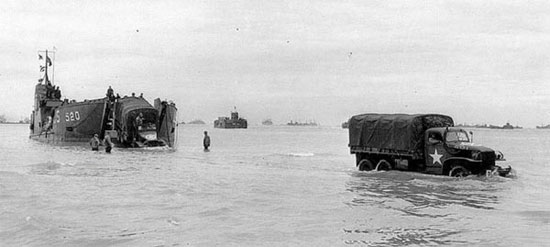
June 8, 1944 – trucks loaded with equipment roll ashore from LCTs.
Beachhead Hospital, June 8-17, 1944:
We disembark on June 8, climbing down the nets to a landing craft. I worry about falling into the sea, but I don’t ! We are put ashore without getting our feet wet. The beach is now more or less secure, and we march inland past fields marked with signs in German warning of mines and littered with crashed gliders. Our Major (this was Major Huber, CO > First Platoon -ed), a self-important Surgeon who imagines he is a paratrooper, ignores his overlay and leads us inland until suddenly we are surrounded by mortar bursts. Diving headlong into the ditches, we become aware of infantry in foxholes shouting at us to get down while questioning our sanity. We retreat, cursing, in haste and embarrassment, wishing that the Major actually was a paratrooper and somewhere else. Two Platoons of the Hospital (probably First and Second Platoon –ed) are already ashore. Together with a Platoon of another Field Hospital (45th Fld Hosp –ed) they have set up north of Le Grand Chemin (-ed). With our arrival we have the making of four complete tent hospitals in one big field.
Wounded men, tagged for identification, are lying on litters in rows all over the field. Walking wounded stand around waiting to be helped. Ambulances arrive with fresh loads. Most are American paratroopers of the 82d and 101st Airborne Divisions, but some are Germans, and others simply unidentifiable foreigners pressed into service by the Germans (probably members of “Ost” Battalions –ed). The enemy soldiers have been at war a longer time, and they stink of dirt sweat and blood. They are given the same treatment as Allied casualties.
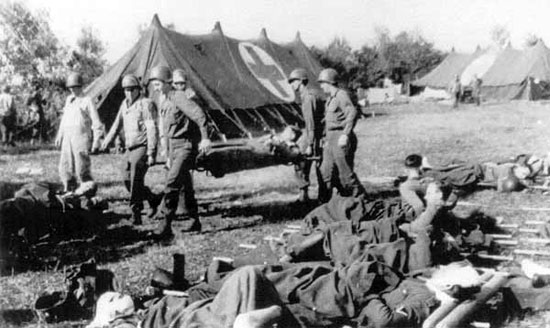
Hospital Ward of the 42d Field Hospital near Utah Beach, early June 1944 – litter bearers and medical personnel (third, fourth, fifth and sixth man from the left, are respectively Sgt Gray, Sgt Randall, Pfc Hammet, and Pvt Marker) – the second man with helmet marking is clearly a medic from the 261st Med Bn / 1st Engr Spec Bde (which also landed at Utah Beach) – note some German patients in the foreground.
I dig my hole beside a hedgerow and report to a tent surgery. I am a Surgical Technician 5th Grade (i.e. a Corporal) who works in a surgery and assists surgeons. A surgeon, a Major, notices me standing uncertainly and says, “Let’s go, Corporal, get some blood on your hands.” Not really funny, perhaps, but then we are all drunk with excitement and determined to do well … I follow him through the blackout curtain into surgery where three surgical teams are at work. Generators outside the tent provide power for lights. I am told to hold a leg while a surgeon saws it off. I wonder why I don’t throw up.

WWII Medical Tags (obverse) – left is an Emergency Medical Tag or Form No. 52b (5 Nov 42), as used by medics and containing essential data related to the patient, right is a Clearing Station Tag or Form 8-29 (12 Jul 44), as used by Clearing Station personnel with indication of admission and disposition dates of patients.
Isolation Tent, June 10, 1944:
The German is dying, but it is taking a long time. I have been sent to a tent at the end of the field, next to a hedgerow, and as far from the hospital tents as possible. The reason is gas, gas gangrene. I am supposed to stay with the German until he dies. There’s nothing I can do to help except to give him water. I cannot speak his language beyond the simple words like yes and no and does it hurt. And he cannot speak mine, except to moan and say “Ja.” He is blond and young and filthy dirty. His wounds exude the odor of gangrene. He does not seem to be a monster. Gas gangrene is our terror. It is a foul infection that flourishes in damaged flesh in the absence of oxygen. Death is virtually certain. Usually you don’t know it is there until you open up a wound. Then it smells to high heaven, someone shouts “gas” and everything in the surgery stops! The man is hurriedly finished and moved away as far as possible from other wounded, lest he infects them. The tent then has to be scrubbed down with disinfectant, and all instrument packs re-sterilized. The night sky is lit by flashes of artillery fire. A lone German plane buzzes overhead, drawing a few bursts of anti-aircraft fire, which falls back on us in the form of shrapnel. A few yards away, the steadily growing hospital dump smells of burning bloody bandages and discarded flesh and limbs. I stare at the German boy, not knowing what to do. Finally, toward morning, he dies.
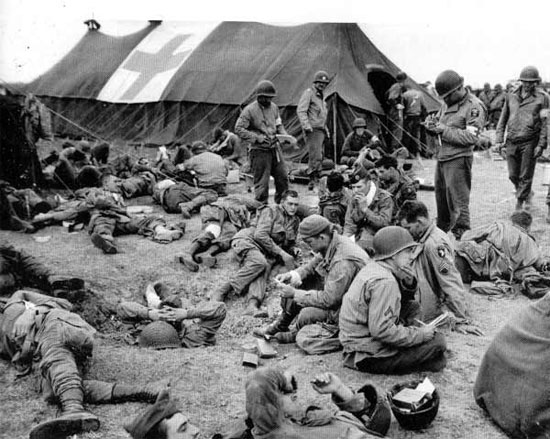
Triage of casualties, among which quite a number of Airborne personnel, somewhere behind Utah Beach, early June 1944.
…. Ward Tent:
A quiet night. Sixty men fresh out of surgery are sleeping on canvas cots. I have drawn ward duty, and dutifully go from cot to cot with a syringe loaded with penicillin, thrusting it quickly into each man’s buttock. It’s a real wake-up call, but most of them are too sick to care. I check IV fluids and suction, give water, take temperatures, and try to ignore the subdued moans of pain that have become a steady background sound. Men who have lost arms and legs are the worst. Some of them, I think, simply talk themselves to death. On most nights, two or three men in each tent die, and their bodies are placed in a truck waiting outside. Each morning it makes the trip to Graves Registration where digging crews bury them in temporary cemeteries … Third Platoon has four tents like this; each one is 50 feet long, (16 feet wide and 11 feet high –ed) supported by 4 poles, and weighs 350 pounds rolled up. Putting it up is an hour’s work for four men.

Surgeons working on casualties near the Invasion beaches, June 9, 1944 …
…. We move as the line moves:
We keep moving. Pont-l’Abbé on June 17, St.-Sauveur-le-Vicomte (-ed) on June 22, Ste-Mère-Eglise on July 6, Carentan on July 10 …. The landscape around is littered with half-destroyed tanks and trucks, blasted houses, dead cows, and in the hedgerows and woods, American and German bodies turning black in the summer sun …. Without knowing why, we are told to change shoulder patches from the First US Army to the Third Army (which became operational as per August 1, 1944 –ed) …. Our trucks roll through the devastated rubble of St. Lô, through villages whose streets are lined with cheering crowds, who push bottles of Calvados and fresh vegetables into our hands, welcome after a diet of K-Rations. Villedieu on August 6, Senonches on August 25, and finally Paris on August 28, where we set up in the outskirts on the Orleans Road and watch the Maquis race by in trucks, firing wildly in the air just to celebrate Liberation.
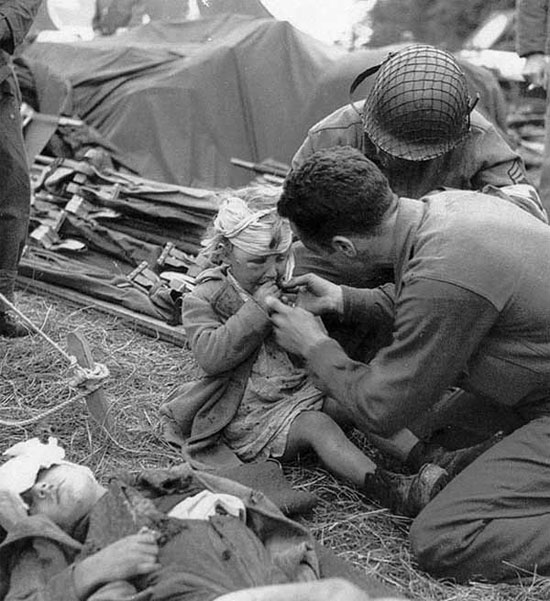
Army medics treating and comforting an injured French child, early June 1944 …
St. Vith, the Ardennes, December 15, 1944:
A long line of tanks clang rapidly northward, past the field where we are playing touch-football with the guys from Second Platoon, somewhere in the Grand Duchy of Luxembourg (Walferdange -ed). It is December, and we have come a long way out of Normandy, through northern France to Paris, briefly into Holland to support the failed Operation called “Market-Garden” and on to the forested hillsides of Belgium. It is getting colder. We have holed up for the winter in St. Vith, a small Ardennes town that lies in a quiet part of the line quite a few miles north of Clervaux (-ed). First Platoon is at another town, further south, Wiltz, near Bastogne (-ed). Occasionally we visit each other. Each town is surrounded by forested hillsides, the fir trees standing out black and green against the white snow.

October-December 1944, Belgium. Officers Russell E. Sewell and Joseph Comroe are taking full advantage of the large Geneva Convention ground marker designating the 42d Field Hospital’s installations.
(During the Battle of the Bulge, the 42d Field Hospital three Platoons were servicing different units at separate locations, i.e. First Platoon – Wiltz (Luxembourg/28th Infantry Division), Second Platoon – Walferdange (Luxembourg/4th Infantry Division), Third Platoon – St. Vith (Belgium/106th Infantry Division), with Headquarters also at St. Vith. –ed).
Our hospital in St. Vith is a three-storey house that must have been some burgher’s pride before the war. Now it is pockmarked with shellfire. We are warm and snug and expect to spend the winter in comfort. The headquarters of the 106th Infantry Division, fresh from the States, is also in town. The Division’s rifle companies and artillery are east of town. We talk constantly of the end of the war, and especially of the new GI Bill. Because I was an Oberlin freshman back home, my friends, who never dreamed of going beyond high school during the Depression years, ask my advice, beginning with questions like “If I did decide to go to college, how would I pick one out ?”
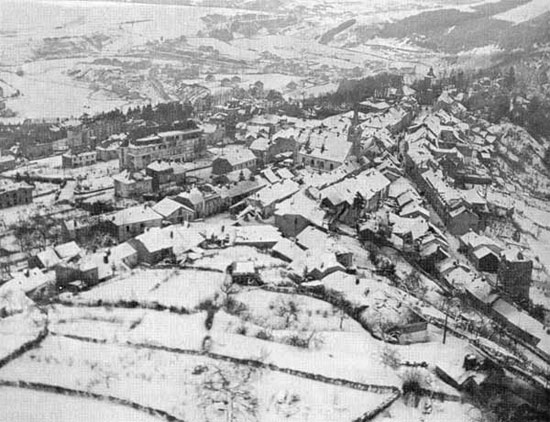
Aerial view of Wiltz (1944).
It is bright late fall weather. The sky is blue, the fallen leaves on the cobblestones are brown and gold. Back home we would have called it perfect football weather. The war seems far away. Maybe it’s over and they haven’t told us.
December 16, 1944:
A quiet day. We have one patient in the entire hospital. But he offers a nervous report: “Something is going on up the line. They’re moving around a lot.”
December 17, 1944:
I guess he was right. I come down to breakfast in the cellar. There are infantry from the 106th all over the place, looking shaken and terrified. Some have lost their weapons or thrown them away. It was the start of the Battle of the Bulge, which we called the “Breakthrough”, because the Germans had broken through the line for one last big drive. The snowy hills around town are beginning to show dark figures coming out of the pine forests. An entire combat command from an Armored Division rumbles through town into the hills. We stand apprehensively outside the hospital and watch them go by. Their confident Colonel tells us not to worry.
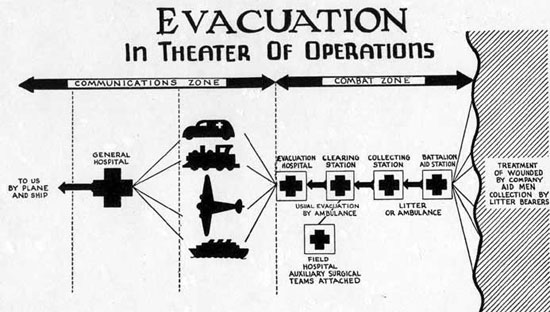
Chain of Evacuation as applied in a Theater of Operations – from Field treatment to Battalion Aid Stations, further through the Collecting Stations to the Clearing Stations, if necessary, emergency cases for surgery to Field Hospitals, and others to Evacuation Hospitals for eventual transportation by ship or plane to ComZ General Hospitals ….
Four hours later, the tanks rumble back through the fog. The same Colonel says, “If you’re coming with us, come on.” We run for our trucks and join his column, leaving the hospital behind. For the first time since June, we are going in the other direction. We are retreating, something we have no experience in doing. The roads are jammed and we make slow progress. By nightfall we have passed the Malmédy crossroads and have settled in a convent at Vielsalm with friendly but suddenly fearful Nuns who talk about “les Boches” coming back. Someone says the Germans machinegunned an entire battalion of American prisoners in a field near the crossroads we had passed two hours before (this is the ‘Malmédy Massacre’, which took place at Baugnez on December 17 – members of B Battery, 285th Field Artillery Observation Battalion were killed by Kampfgruppe Peiper -ed). The next 10 days are a nightmare. Without air support because of the dismal weather, we keep falling back, getting lost in the fog, hearing stories of Germans in GI uniforms, staring at the thick clouds as if we could make planes come by force of willpower. Always the word is, “The weather is too thick to fly.” We curse people who fly airplanes, who are never hungry and cold, and who never sleep in the snow.
We are in Sedan by Christmas Eve:
A rotten Christmas, but we are putting a hospital together again with new stuff from the medical dumps. Days later the weather finally breaks, the planes come, wave after wave of them. Hundreds and hundreds of B-17s and B-24s and everything else with wings fill the sky. We stand outside waving and screaming like schoolboys at a football game: “Go, go, go!”

25 December 1944, France. Christmas poem and texts prepared by the 42d Field Hospital’s Chaplain John S. Rankin.
…. We hear the Second Platoon has been partly captured in Wiltz, and marched into Germany to a prison camp . One of the cooks was killed when the column was strafed on the road (in fact, it was the First Platoon, which when evacuating Wiltz, had to leave behind 22 non-transportable patients with a surgeon and a number of enlisted technicians who volunteered to stay. They were all marched into captivity to Germany December 19. The Second Platoon was located near Walferdange, while the Third was at St. Vith (-ed) .
Neufchâteau, Belgium, January 9, 1945:
Major Lamar Soutter, age about 35, with sandy curly hair, horn rimmed glasses, and a patient voice resonant with the authority conferred by 300 years of Harvard. The voice is never raised, and the lowliest of enlisted men is patiently addressed by name followed by please and thank you. At home in Boston he is a well connected young chest surgeon. Here on the edge of the Siegfried Line, he is that rarity along commissioned officers, the idol of his enlisted men. Of all our surgeons, he is the best. Soutter is just out of Bastogne, having volunteered to be dropped by glider into the surrounded town where more than a thousand casualties lay in a warehouse under the care of a single surgeon. Blood and plasma were gone. Third Army asked for volunteers. Soutter and eight other surgeons and technicians responded and were loaded with fresh blood and drugs into a glider towed by a C-47 and cut loose to drift to a snowy field at the edge of town. Major Soutter said later that the first day in the warehouse they did 56 operations.
By the 26th (-ed), the 4th Armored Division had broken the siege. The Major and his team were given Silver Stars and assigned to us. We have become friends, and spend considerable time together mixing grapefruit juice and the contents of a 5-gallon can of medical alcohol that somehow made its way from the medical dump at Bastogne to the Major’s tent concealed in an old barracks bag.
Elxleben, Germany, April 13, 1945:
I am sleeping on the floor of a battered house we have made into the hospital when someone shakes me. “Wake up. Roosevelt is dead, Truman is President, and it’s time for your shift.” The words are a shock. FDR has been President for nearly my entire life. I can’t imagine the country or the war without him. I have never heard of Truman. I get up and go into the surgery where I relieve another technician and am told to give a patient on the table a pint of plasma. My hand shakes so much I cannot find the vein.
Ohrdruf and Buchenwald:
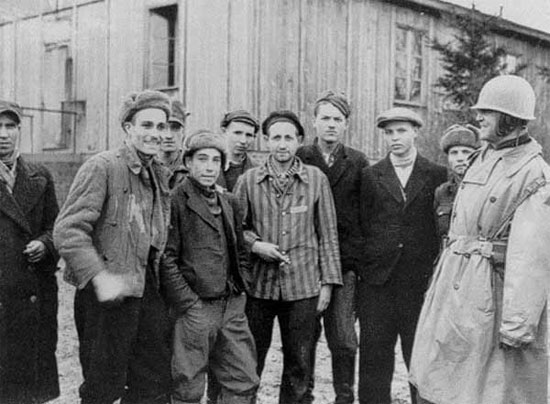
Ohrdruf KZ, Germany, April 4, 1945 -Survivors just liberated by troops of the 4th Armored Division. Of note is the soldier standing at right who wears the M-1938 Tanker Helmet underneath a whitewashed M1 helmet shell.
As the war winds down and we get deeper into Germany, the secrets begin to show. In Bavaria we take over a German hospital established in a handsome Monastery at Maria Lach. As we roll up in our trucks, German Officers emerge from the building on their way to prison camps. They wear long gray winter overcoats, and scowl at us. Days later we are ordered to send a medical detail up to a place called Ohrdruf where a concentration camp has been discovered. They return with pictures and stories of opening up the camp to find it full of starving men and heaps of corpses, and how they forced the mayor and a group of citizens from the nearby town to walk through the camp, and how they said they knew nothing of what went on there. It is a response we hear more than once from that day on and seems hard to believe. At Buchenwald we enter the camp through the main gate to find the same heaps of corpses, this time many of the guards were caught by the liberated prisoners before they could escape to safety. We walk through the barracks staring at naked skeletal men on their wooden bunks.
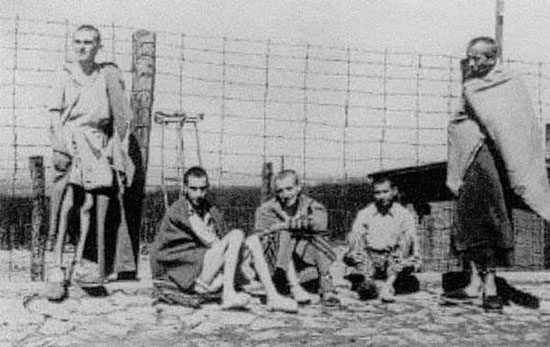
Buchenwald KZ, Germany, April 11, 1945 –
poor emaciated bodies, camp inmates,
after their liberation by elements of the 6th Armored Division …
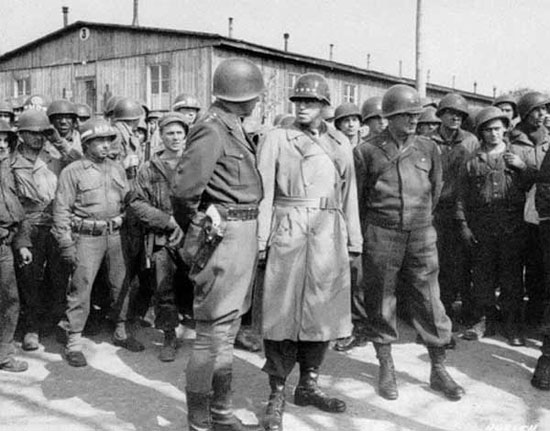
Germany, April 12, 1945 – Army brass (Generals Patton and Bradley) visiting Ohrdruf KZ, subcamp of Buchenwald, FIRST Concentration Camp liberated by troops of the 4th Armored Division April 4, 1945.
Pfeffenhausen (near Munich) May 7, 1945:
Our last setup. It is clear that the war is ending. The Germans we see now are mostly old men and 14-year boys barely able to carry a rifle, and we have few wounded to work on. Major Soutter wants to see Munich, where he had been a student tourist before the war, so he orders a weapons carrier and a driver and off we go to see Munich. The city is chaotic, a scene out of Dante’s Inferno. Crowds fill the streets looting at will in the bombed-out remains of buildings and stores: Germans, Americans, British, French, DPs (displaced persons) from a dozen conquered countries, inmates from the concentration camps in their striped pajamas. We stand in the great square in front of the City Hall (?) to see if the famous clock still works.
Strangely, it does! The Major spots a line of people going into the cellar of a bombed hotel and emerging with bottles of wine. He halts the truck, then orders the rest of us to join the line waiting for a turn in the cellar. I lead the way into the dark, noting with amazement that the looters are perfectly polite and self-organized. Not a word is said as the line shuffles down the stairs. At the bottom I see in the dim lights hundreds of bins reaching to the ceiling, each with dozens of bottles of Rhine wine on their sides. I climb into a top bin and hand down 10 bottles to each of my friends without so much as looking at the labels, and we go up the stairs again into the light. In the truck we find of course, that we have no corkscrew. The Major, who is a graduate of both Harvard College and Harvard Medical School, knocks off the top of the bottle by striking it against the side of the truck. As we start for the hospital, I see a man in concentration camp pajamas coming out of the cellar with a two-gallon jar of dill pickles. The US Army does not run dill pickles in wartime, and I have a powerful homesick hunger. I offer him a pack of Lucky Strikes, point to the jar, and off we go, eating dill pickles and drinking Rhine wine from broken bottles.
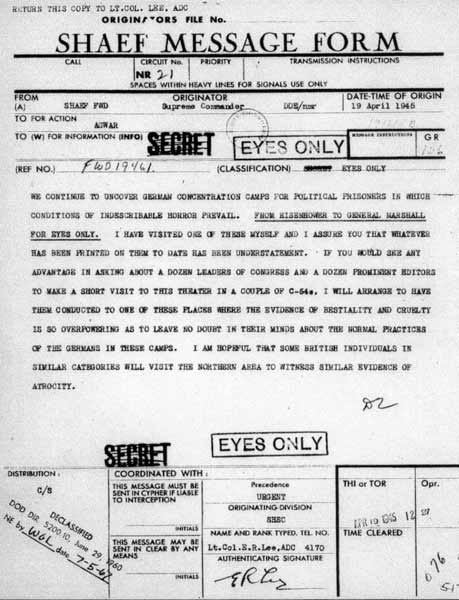
SHAEF Message dated April 19, 1945, from IKE to General G.C. Marshall informing the latter of the discovery of German Concentration Camps during the Allied advance …
A sunny hillside, May 8, 1945:
The results are predictable. I wake up in a field near the hospital sometime the next day, desperately sick. Someone has stolen several chickens which we proceed to cook over a portable sterilizer stove set up on the hillside. A constant stream of Allied soldiers newly liberated from German prison camps are walking aimlessly down the highway: Americans, British, Indians, French. We share our chicken and the remains of the wine. The war is over …
Unless otherwise stated, and except for a few editing remarks and extra illustrations, all texts in this testimony are courtesy of Tec 3 James K. Sunshine (ASN:15359023), who was an active member (Surgical Technician) of the 42d Field Hospital in WW2. The MRC staff are truly thankful for sharing his personal reminiscences with them. We like to further express our sincere thanks to Susan King, daughter of 1st Lt Russell E. Sewell (O-1547787) for kindly allowing use to use some additional pictures from her Father’s WW2 scrapbook.
